Allons enfants de la patrie
le jour de gloire est arrivé!
The FCM 36 was a French light infantry tank, created in the interwar period. Its concept and design can be considered progressive and modern for the time: it was the first tank (before the famous T34) with sloped armor to be put into production. While other French tanks and most other countries were mounted with screws or rivets, the FCM brought its armor almost completely welded. Furthermore, the FCM 36 had a diesel engine, which increased the operating range and minimized the risk of fire. But unfortunately, because it was so innovative, it was very expensive and few were built. We can say that the Char léger FCM 36 was ahead of its time... Come with me to meet this nice girl.
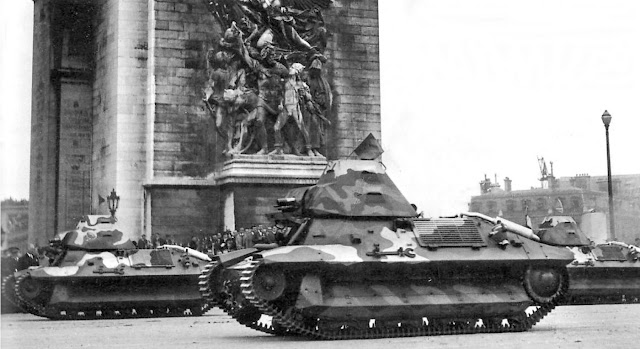 |
| FCM 36 light tanks of the I-503 RCC (later 7e BCC) Parade of November, 1938 - Paris - France |
History:
The FCM 36 or Char léger Modèle 1936 FCM, was a light infantry tank that was designed for the French Army prior to World War II. It weighed around 12 tons and was powered by a 91 hp diesel engine. Like many tanks of the time, had a crew of two and was equipped with a short 37 mm main gun and a 7.5 mm coaxial machine gun.
Development:
In 1933 the Hotchkiss company proposed to build a cheap mass-produced light infantry tank. In reaction to this proposal the French Army invited the whole of French industry to offer alternative designs. In the end three of the competing prototypes would be taken into production: the Hotchkiss H35, the Renault R35 and the FCM 36.
 |
| The 1st prototype of a Hotchkiss light tank (2 were built). No turreted - bolted casting armour January - 1935. |
 |
| The 3rd Hotchkiss prototype received a new upper hull and an early APX R turret. and the same six small road wheels per side, coupled into 3 bogeys. July - 1935 |
 |
Renault ZM prototype (father of Renault R-35) on trials Notice the turret with two machine guns and 3 bogeys with 5 road wheels late 1934. |
The Forges et Chantiers de la Méditerranée (FCM), located at Toulon, had some previous experience with tank production as it had constructed the ten giant Char 2C tanks in 1921 and had been involved in the development of the Char B1.
 |
| Char 2C 90 (10) Poitou heavy tank See more here, in Panzerserra Bunker |
 |
| Char B1 - FLANDRES (128) heavy tank |
Engineer Bourdot, who had designed the suspension of the Char B, was ordered to create a modern tank design taking full advantage of the large electro-welding capacity of the wharf. In March 1934 he presented a wooden mock-up that was approved by the Army. On 2 April 1935 the prototype was delivered to the Commission de Vincennes, with a turret equipped with a Puteaux SA 18 37mm gun and 7.5 mm MAC31 Reibel machine gun coaxial.
 |
| First prototype for FCM 36 light tank: Tracteur RN3 prototype no. 1 Notice the sloped armour April - 1935 |
The commission was quite impressed by the vehicle, especially because of its welded sloped armour and the use of a diesel engine promising a good range. It was a bit heavier than the specified nine metric tons at 10,168 kgs. However the prototype was untestable because of mechanical problems. After the first evaluation had been finished on 9 June it was sent back to the manufacturer.
In fact FCM had not tested the prototype itself yet; this was now done and many shortcomings became apparent. As a result, the vehicle was completely redesigned with a new and lighter hull and turret configuration, suspension and track. The roof of the engine compartment was now bolted on to ease replacement. On 10 September it was again sent to Vincennes only to be sent back on 23 October to have its suspension reinforced.
 |
| 2nd prototype of the Tracteur RN3 Notice the sloped welded armour, new turret design and new tracks, with better grip. September - 1935 |
On 19 December it returned to be tested until 14 May 1936. It was then approved on the provision that the armour would be thickened from 30 to 40 mm, according to the new specifications. This was done by welding an appliqué 10 mm armour plate on top of the main armour, a feature maintained for the production vehicles.
The prototype was now brought to the attention of the Commission d'Infanterie, who declared on 9 July that it was the best of all competitors, especially since it had been proven on 17 June to be completely gas-proof, a unique quality that was considered a very desirable feature at the time.
Production:
Even before the type had been approved however, because of Germany's remilitarization of the Rhineland, on 26 May an order was hastily made for 100 vehicles of the Char léger Modèle 1936 FCM for 450,000 FF a piece. The tanks were numbered from 30001 to 30100.
 |
| FCM 36 light infantry tank - color profile |
The Hotchkiss H35 and Renault R35 light tanks would also be brought into production, and as these competing types were much cheaper, they would make up the bulk of the French light infantry tanks produced. The reason for co-producing the third most expensive type was its development potential. An important detail to be mentioned is that the turret rings of these light tanks were all of the same diameter, that is, there could be the possibility of interchangeability between turrets and hulls.
The FCM 36 was seen as the most advanced French tank and should function as a test bed for further improvements. This also meant there was no hurry to start series production. The production facilities only began to be prepared from December 1936 and actual manufacture was delayed for a year to first test a newer design with a stronger engine and a lighter track. Only when this did not render the expected results, the original type was produced, with the first delivery on 2 May 1938. During 1938 and 1939 several modifications were tested on vehicle number 30057 including a new track, clutch and engine, but none of these would be applied on the existing vehicles.
On 12 May 1938 and 3 February 1939 two additional orders were made of a hundred each. However, when the last tank, series number 30100, of the original order was delivered on 13 March 1939, FCM suddenly announced that it would permanently cease production unless the price was raised to at least 900,000 FF, apparently the actual cost of production. Also FCM indicated that given its increased demanded production quota of the Char B1, there simply would be no capacity to manufacture any FCM 36s before September 1940. In view of these circumstances Inspector-General Jacomet allowed the production of the hull to be discontinued. although the manufacture of the turrets was maintained.
 |
| Char B1 heavy tank - color profile |
The FCM turret had already been planned to become the standard for all light tanks, as the old APX-R standard turret early on suffered serious production delays.
 |
| FCM turret - right side Musée des Blindés - Saumur - France |
 |
| FCM turret - front side Musée des Blindés - Saumur - France |
.jpg) |
| FCM turret - interior Notice the breech of Puteaux SA 18 37mm gun and 7.5 mm MAC31 Reibel machine gun coaxial. (right side) |
Relative to the FCM turret, the APX-R turret was tighter (if that was possible), heavier (1.552 to 1.287 kg) and even inferior in protection to the FCM turret, due to constant quality issues with its cast steel that was too soft or too soft fragile.
 |
| APX-R turret in Renault R35 tank on display at King Ferdinand National Military Museum Bucharest - Romania |
Because it is better armored, sloped-shaped and easier to build, the use of the FCM turret would be extended to the entire French light tank fleet. The possibility of using both types of turrets on the hulls of light tanks was an important logistical and maintenance facilitator.
 |
| FCM 36 light tank dressing an APX-R turret equiped with the short Puteaux SA 18 37mm gun |
 |
| R35 Renault light tank with FCM turret equiped with the short Puteaux SA 18 37mm gun |
However, this issue of standardization of the FCM turrets was complicated when tests of fire were carried out to enable the installation of a more powerful version of the Poteaux SA 18 cannon. The longer Poteaux SA 38 37 mm gun was installed in the turret of the FCM 36 tank nº 30057, for live fire tests. After the tests, it was found that the welds of the FCM turret had cracks and fissures, due to the stronger recoil of the new weapon. With this, to enable the installation of the most powerful weapon, all the turrets already manufactured had to be reinforced, which was almost impossible to execute in view of the political pressure existing at the time. As a result, existing vehicles would not be equipped with the new weapon. The APX-R turret, for being casted, without welds, did not have this problem, being the option to receive the necessary upgrade of the most powerful armament.
 |
37mm SA 38 tank gun right side Musee Des Blindes - Saumur - France |
 |
37mm SA 38 tank gun left side Musee Des Blindes - Saumur - France |
 |
| 37mm SA 38 tank gun installed in the FCM 36 turret - tank no.30057 left view |
 |
| 37mm SA 38 tank gun installed in the FCM 36 turret - tank no.30057 right view |
 |
| 37mm SA 38 tank gun installed in the FCM 36 turret - tank no.30057 right view |
Description:
The FCM 36 was a small vehicle, 4.46 m long, 2.20 m high and 2.14 m wide, with a crew of two. It has a weight of 12.35 metric tons.
 |
| FCM 36 light tank front view Saumur - France |
The armour consists of many panels electro-welded together into an pyramidal shape to avoid shot-traps and fully implement the principle of sloped armour. Such a configuration was unique at the time. This included the upper track run and the suspension units, protected by zig-zag armour plates. The engine deck is the only armour which is bolted as this enables easier access to the engine.
 |
| FCM 36 light tank - rear view notice the bolted rear armour Saumur - France |
As the armour is of good quality, the 40 mm thickness angled at 30 to 45 degrees from the vertical, renders an equivalence of about 45–55 mm, enough to regularly defeat the standard anti-tank guns of its day, even when the gun was ideally positioned. The reclining armour implied that more raking shots would quickly start to deflect. The type was the only actually produced French tank of the period that featured a diesel engine, which gives the vehicle a superior range of 225 kilometres from a fuel tank of 217 litres. In other aspects, it conformed to the French design standards. French tanks were usually slow compared to their German, British or Soviet counterparts. The V-4 91 hp Berliet diesel allows for a top speed of just 24 km/h.
 |
| BerlietV-4 diesel engine - FCM 36 light tank video frame from Musée des Blindés Saumur video |
The suspension is accordingly simplistic, consisting of eight road wheels per side sprung by eight vertical coil springs. The tank can cross a two metres trench and climb a 70 cm obstacle or an 80% slope. Also very limited is the armament: apart from the Reibel Mitrailleuse modèle 1931 7,5mm machine gun, the standard short Puteaux L/21 37 mm SA 18 gun was fitted, a cannon with very poor anti-armour capacity.
Operational use - France:
As 100 FCM 36s were to be produced, only a limited number of units would be equipped with the type. However these would happen to participate in the key event of 1940 during the Battle of France: the crossing of the Meuse river, by XIX Army Corps of Heinz Guderian on 14 May 1940.
 |
| General Heinz Guderian in a SdKfz. 251/3 halftrack command vehicle - France, May 1940. |
In March and April 1939 two battalions were created. Unique among those battalions equipped with light infantry tanks, these units would be called Bataillon de Chars Légers or BCLs: the 4e and 7e BCL, that each received 45 FCM 36s. They had an organic strength of 39 (three companies of thirteen), a materiel company of six and used five tanks for driver training. Of the other ten tanks, eight were used for driver training, one was destroyed testing the efficiency of the German Teller mine, and one remained with the factory to serve as a test bed. On 25 August 1939, upon mobilisation, the BCLs were renamed Bataillons de Chars de Combat. The 7e BCC was incorporated into the 503e Régiment de Chars de Combat, the 4e BCC into the 502e RCC.
 |
| FCM 36 (30004) from 7e BCC - 2e Cie - 2e Sect. showing its immaculate and colorful camouflage. She would be destroyed on the road from Maisoncelle to Chemery France - May 14, 1940 |
After war was declared against Germany in September 1939, both FCM 36 battalions were combined, together with 3e BCC, a R 35 unit, into the 503e Groupement de Bataillons de Chars, the armour reserve of the Second Army. When German infantry on 13 May 1940 established a bridgehead over the Meuse at Sedan, the FCM 36 battalions were late in the afternoon ordered to counterattack and reduce it, cooperating with an infantry regiment, as they themselves had no organic infantry component.
 |
| Panzer IV crossing the Meuse, France - May -1940 |
Due to the rout of the last French defence line at Bulson during the night and the ensuing confusion, the approach march could not begin until early in the morning of the 14th, when the first German tanks started to cross the river on pontoon bridges. The German armoured vanguard and 7e BCC collided near Bulson. French FCM 36 tanks destroyed some lighter German armored fighting vehicles such as the Panzer II and I, but their short guns were too weak in penetrating power to deal with the 30mm armor of the Panzerkampfwagen III, although the latter also had trouble penetrating. the thick and sloped armor of the FCM 36, with its 37mm guns from the early series.
 |
Panzer III Ausf. E destroyed near Sedan. Notice the 3.7 cm KwK 36 gun France - 1940. |
Both sides slugged it out, often engaging at the shortest possible distance, to increase the effectiveness of their weak cannons. In the end, the FCM 36's applied armor failed and the welds, being the weakest points between the plates, including the bottom corners of the turret just above the hull, were penetrated. The 7e BCC had to withdraw, leaving 26 of the 36 tanks employed behind.
%20on%20May%2014,%201940.%20The%20crew%20died%20in%20combat..jpg) |
| FCM 36 - 30015 LE ZEPHIR 7e BCC 1ère Cie 3e Sect. Destroyed at the western exit of Maisoncelle (Ardennes). The crew died in combat. May 14, 1940 |
 |
| Destroyed FCM 36 tanks, abandoned on the road to Maisoncelle (Ardennes), being examined by the Germans. May 14, 1940 |
 |
FCM 36 - 30025 - 7e BCC 1ére Cie turret showing multiple penetrations on its side. Destroyed on the road to Maisoncelle (Ardennes) May 14, 1940 |
 |
| FCM 36 - 30001 Le Mistral Destroyed on the road from Maisoncelle to Chemery - Ardennes May 14, 1940 |
%20on%20May%2014,%201940.jpg) |
| FCM 36 - 30057 -7e BCC 3e Cie 2e Sect. This was the tank that tested the 37mm SA 38 tank gun Destroyed at Chemery (Ardennes) road. May 14, 1940 |
When 7e BCC had failed, the attack by 4e BCC was halted. The battalion attacked and defended Stonne on 15 May, but was driven from this key position with some losses. Until 23 May it would be attached to 3 DIM.
Both battalions were now kept in reserve to rebuild their numbers from the matériel and training units. During Fall Rot they executed successful counterattacks on 9 and 10 June on the Aisne river position, against German infantry units. Later they tried to cover the retreat of the French Army, losing most of their combined strength of 45 in fights with German tanks.
%20on%20June%2010,%201940.jpg) |
| FCM 36 - 30026 - 7e BCC 2e Cie 1ère Sect. Destroyed at Attigny (Ardennes) June 10, 1940 |
%20on%20June%2010,%201940.jpg) |
| FCM 36 30028 7e BCC 2e Cie Destroyed at Attigny (Ardennes) June 10, 1940 |
-4e%20BCC%202e%20Cie%20%202e%20Sect.-%20Destroyed%20at%20S%C3%A9zanne%20(Marne)%20on%20June%2013,%201940.jpg) |
| FCM 36 - 30040 COMME TOUT LE MONDE (white52) 4e BCC 2e Cie 2e Sect.- Destroyed at Sézanne (Marne) June 13, 1940 |
Markings:
The FCM 36 was generally painted by FCM in a distinctive pattern with light grey blue (gris bleu clair) or pale yellow (jaundtre) at the top, and horizontal rolling bands of red brown (sepia), pale green (reseda), beige, and dark green (vert fond). The 7e BCC usually used a distinctive circular emblem on the turret front, based on the regimental insignia of the 503e RCC, a stylized tanker firing a machine gun. It was reproduced in company colors with the 1e Companie in all blue, the 2e Companie with the gear in white, and the 3e Companie with the gear in red. This is the tank of the commander of the 4e Section, 1e Companie, Aspirant (reserve) Pierre Cassier, named "Le Temeraire" (Reckless). Although not visible from this angle, the turret had a medium blue "club" insignia on both turret rear corners, about 30cm (1 foot) high. This followed the French tank tradition since World War I of using playing card symbols to distinguish subunits. The order in this unit was 1e Section (spade), 2e Section (heart), 3e Section (Diamond) and 4e Section (Club). These were in the company color (le Companie: blue, 2e Companie: white, 3e Companie: red).
The end and the use by Germans:
With the fall of France in 1940, captured FCM 36s intact or in good repair were kept in their original state as gun tanks and were therefore named Panzerkampfwagen FCM 737(f). However, for logistical reasons, it seems they saw very little use in France in the 1940s. After some improvised use by units in May and June 1940, they were not as such employed by them.
 |
| FCM 36 - 30022 7e BCC 1ère Cie 2e Sect. Color profile of the vehicle above |
 |
FCM 36 -30061 4th BCC 1st Co. 1st Sect. Lost at Voncq (Ardennes) on June 9, 1940 - captured and used by Germans |
 |
| FCM 36 -30061 4th BCC 1st Co. 1st Sect. Color profile of the vehicle above |
The big problem with the operational use of these tanks was logistics: the German panzers used gasoline and the FCM 36 were powered by diesel. Although diesel was supplied to the heavy trucks, this supply discrepancy was always a problem in the use of the FCM, and the surviving tanks were stored for future emergency use. And, around 1942, the Germans decided to use the chassis of the FCM 36 for conversion into self-propelled artillery and tank destroyers.
From six to twelve (numbers are not precise) FCM 36 chassis were rebuilt as self-propelled artillery, the 10.5 cm leFH 16/18 (Sf) auf Geschuetzwagen FCM (f), in 1942. There are records that eight being sent to Sturmgeschuetz-Abteilung 931 (931st Assault Gun Battalion), in 31st October 1942 and later four more being sent to the same unit in early 1943.. This unit’s long name is often abbreviated to Stu.Gesch.Abt. 931.
 |
| 10.5cm leFH 16 auf GW FCM 36(f) being finalized at the factory. Note the absence of frontal armor on the gun. |
 |
| 10.5 cm leFH 16/18 (Sf) auf Geschuetzwagen FCM (f). box art from ICM model kit (#35340) |
In 1943 ten chassis were rebuilt as Marder I tank destroyers, with the 7,5 cm PaK 40 anti-tank gun and officially called 7.5cm PaK40(Sf) auf Geschützwagen FCM(f). These destroyers were employed by 21 Panzerdivision in the Battle of Normandy in 1944.
 |
| An immaculate 7.5cm PaK40(Sf) auf Geschützwagen FCM(f) of the Marder I family, in the process of being delivered to your unit. |
 |
| Marder I on FCM 36 base - ICM model kit (#35339) box art |
Only one FCM 36 survives at the Musée des Blindés at Saumur. It has been restored to running condition.
Specs:
| FCM 36 | |
|---|---|
| Type | Light infantry tank |
| Place of origin | France |
| Service history | |
| Wars | World War II |
| Production history | |
| Designed | 1933–1936 |
| Manufacturer | Forges et Chantiers de la Méditerranée |
| Unit cost | ₣ 450,000 |
| Produced | 1938–1939 |
| No. built | 100 |
| Specifications | |
| Mass | 12.35 metric tons |
| Length | 4.46 m |
| Width | 2.14 m |
| Height | 2.20 m |
| Crew | 2 (commander, driver) |
| Armor | 40 mm |
Main armament | 37 mm L/21 SA 18 gun |
Secondary armament | 7.5 mm MAC31 Reibel machine gun coaxial |
| Engine | V-4 Berliet diesel engine 91 hp (67 kW) |
| Power/weight | 7.36 hp/tonne |
| Transmission | 5 forward, 1 reverse |
| Suspension | vertical coil spring |
| Ground clearance | 0.36 m |
| Fuel capacity | 217 litres |
Operational range | 225 km |
| Maximum speed | 24 km/h |
The kit:
For this comission project, I'll use this option, from ICM Models:
 |
| ICM kit (#35337) box art FCM 36 - French light tank in German service |
My client requested his model with the French colors, but in the store that I acquired this model, this was the only version of this kit available. Fortunately that all kits are the same, just changing the decals of the markings... and that really won't be a problem... But enough talking and let's move on...
 |
| My workbench, with the ICM kit parts... |
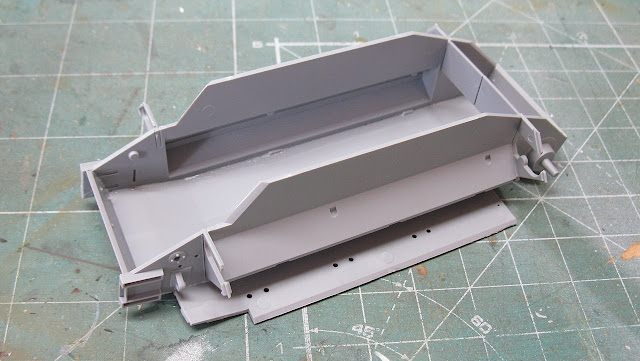 |
| Starting by the booklet, by the chassis, gluing the parts togheter. The kit is very well detailed and injected... |
 |
| The fit of the parts is perfect. So far, a delight to build, no doubt.... |
To glue the bogie wheels perfectly aligned to each other, I made a "Mad Scientist" invention: I used thick metal wire, which I sanded to the same size of the inside diameter of the wheels, using the Dremel as a vise.
I kept the metal pin installed in the Dremel mandrel (I didn't use the Dremel rotating, just as a support...) and inserted the two wheels in this axle, to be able to glue them together, perfectly aligned. Simple and effective.
 |
| The Panzerserra "Wheel Aligner Tool" (patent pending), ready to receive the two wheels to be glued together. The objective is to make pairs of perfectly aligned wheels for the suspension bogies. |
 |
| Parfait, as Brigitte would say... |
 |
| And the bogies and drive sprockets in position... Tout parfaitement aligné... |
 |
| While the superglue dries on the tracks, we continue to build our little girl's suspension and lower hull... |
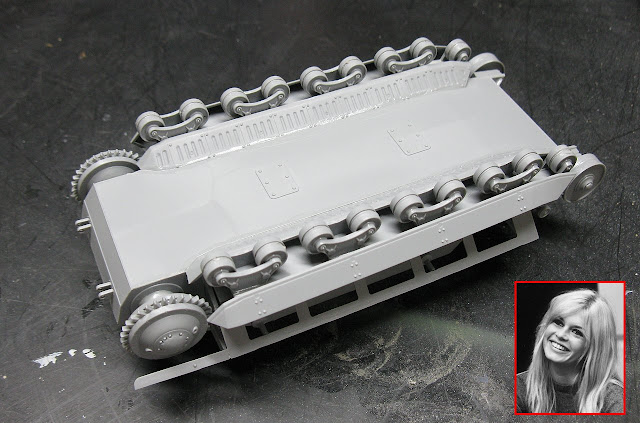 |
| Really, a très jolie et sympathique little girl !! |
 |
| I almost broke this delicate piece when handling the tank... Don't worry mon chéri...it's easy to fix!!! |
 |
| And ready !! Tout est parfait!!! |
 |
| As I said before, this kit is very nice to build... left view |
 |
| Right view. As the kit does not have interior details, I left the driver's hatch half-open... |
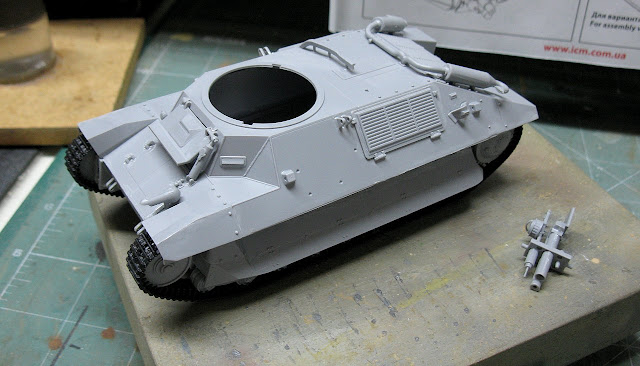 |
| Adding the hull details and starting to build the armament... |
 |
| Soooo pretty!! |
 |
| Starting the construction of the pyramidal turret. Horus says: " * Nice turret..." |
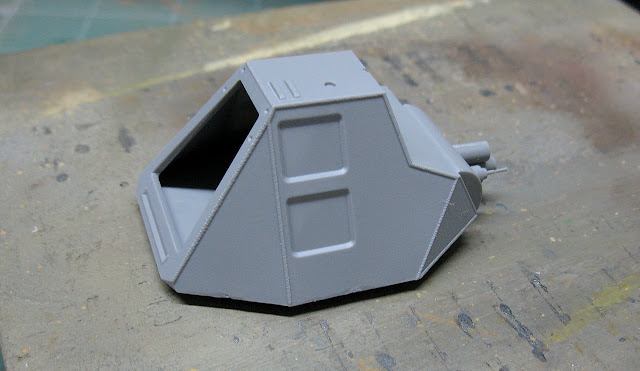 |
| Turret - right view |
 |
| The kit is ready for painting.... |
For this project, I choose represent the brave FCM 36 30056, who fought on May 14, 1940 at Chemery (Ardennes).
 |
| The FCM 36 - 30056 in parade. November, 1938 - Paris - France |
This tank was serving in the 7th Battalion of Tanks, in the 3rd Company, 2nd Section. The crew consisted of Second Lieutenant Jacques Lacroix (Commander) and mécanicien Perrelet (driver). On its way to Chemery, the french tanks encounters three heavier German tanks. The FCM 36 30056 immediately starts firing, imitated by the other French tanks. Second Lieutenant Lacroix's 30056 "White 51" tank is quickly hit and he is mortally wounded. But somehow he managed to crawl out of the tank's turret and was taken prisoner. The driver Perrelet takes his post and continues to fight. We don't know what happened to him.
 |
| The FCM 36 30056 "White 51" destroyed after the Battle of Chemery - Ardennes - 14 May 1940. |
 |
| The FCM 36 30056 "White 51" destroyed after the Battle of Chemery - Ardennes - 14 May 1940. |
As usual, I try to make a color profile, as a guide for my paintings and markings:
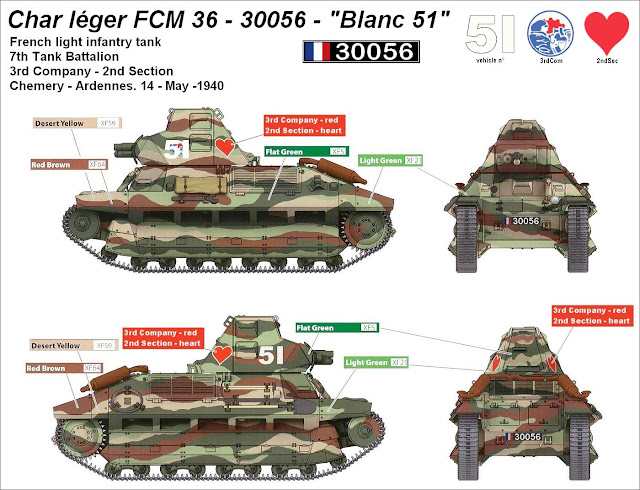 |
| Light tank FCM 36 - 30056 - "White 51" |
And our industrious bald guy received a priceless gift from our friend Marsy Olivier, sent from beautiful France: The book Trackstory FCM 36 (Editions du Barbotin n° 7), with great historical and graphic material about our little girl, with a nice sheet of decals,with precisely the markings of le Blanc 51!!
Merci beaucoup, mon ami Olivier!!!
 |
| The bald one with with your new gifts!!! |
But suddenly, Kojak suffers a paroxysmal attack of "rivet counter disease": Looking closely at the Trackstory decal, he discovers an error in the colors of the markings referring to the Tank Company: the emblem on the decal came with the gear painted blue (the blue ones were from the 1st Company, as we saw above, in the Historic). But as the Le Blanc 51 belongs to the 3rd Company, it would be correct for this gear to be painted red. But that's easy to fix: just use a very fine brush and steady hands to turn the blue gear red... Let's do that in the decal sealing step... But even with this small problem, the decals made our life a lot easier, saving us hours of work!!!! See the detail below:
 |
| Trackstory's decal with a small coloring error on the emblems of the 3rd Company. |
But first of all, primer time!!!
 |
| Light grey primer |
 |
| Fisrt base color: a rather pale desert yellow, with tonal variations... |
 |
| Now it's time to make a lot of masks for the "discreet" french camouflage!!! |
 |
| Some of the masks in position... a boring job... |
Sorry, my friends, but I got so caught up in cutting and applying the tapes that I didn't take all the pictures of this step... Here's the result of the color layers, after removing the masking tape:
 |
| Vive la France !!! FCM 36 - front left view |
 |
| FCM 36 - front right view |
 |
| FCM 36 - right view |
 |
| FCM 36 - left view |
Now, it's time to apply a thin layer of Pledge over the entire light tank and wait for it to dry, to apply the decals without running the risk of having the infamous silvering....
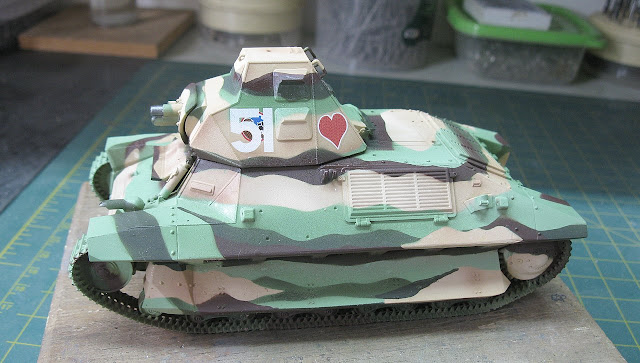 |
| Le Blanc 51 being born... Notice that the visible portion of the blue gear on the turret's emblem is very small... Good thing it's only on the left side!!! |
 |
| FCM 36 Le Blanc 51 - 30056 |
 |
| The "Red Heart" of 2nd section is sooo cute in this girl!!! |
 |
| Fixing the wrong color detail of Company emblem gear Le Grand Charles était ravi !!! |
 |
| Indeed, much better... Le Grand Charles agree!!! |
 |
| Starting the weathering... Notice the exhausts in the rear deck... |
 |
 |
Starting the weathering... Notice the exhausts in the rear deck... |
 |
| FCM 36 Le Blanc 51 - 30056 |
 |
| Let's add something from the crew on this little girl... Value Gear Details are always a good request... testing the position of the roll bags |
 |
| Value Gear Details stuff testing the position of the roll bags |
 |
| Primer in the roll bags...I always paint more of these details...for other projects... |
 |
| Roll bags for the Le Blanc 51 |
And after the roll bags are applied and the weathering is finished, we can call this little girl ready. With you, Le Blanc 51: Char léger FCM 36 (30056) from 7th Tank Battalion; 3rd Company, 2nd Section. She bravery fought in Chemery, Ardennes - France, in 14 May 1940.
 |
| Le Blanc 51: Char léger FCM 36 (30056) 7th Tank Battalion; 3rd Company, 2nd Section. Chemery, Ardennes - France - 14 May 1940. |
 |
| Le Blanc 51: Char léger FCM 36 (30056) front right view |
 |
| Le Blanc 51: Char léger FCM 36 (30056) front left view |
 |
| Le Blanc 51: Char léger FCM 36 (30056) left view |
 |
| Le Blanc 51: Char léger FCM 36 (30056) rear left view |
 |
| Le Blanc 51: Char léger FCM 36 (30056) rear left view |
 |
| Le Blanc 51: Char léger FCM 36 (30056) right view |
 |
| Le Blanc 51: Char léger FCM 36 with Kojak. |
 |
| Le Blanc 51: Char léger FCM 36 (30056) with Vickers light tank Mk VIB |
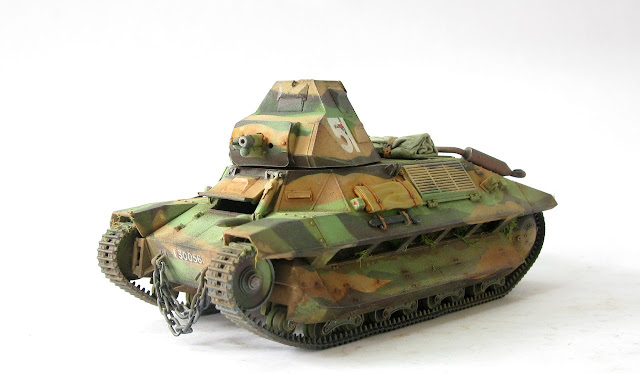 |
| Le Blanc 51: Char léger FCM 36 (30056) 7th Tank Battalion; 3rd Company, 2nd Section. Chemery, Ardennes - France - 14 May 1940. |
Merci de suivre ce projet !!!
À bientôt!!












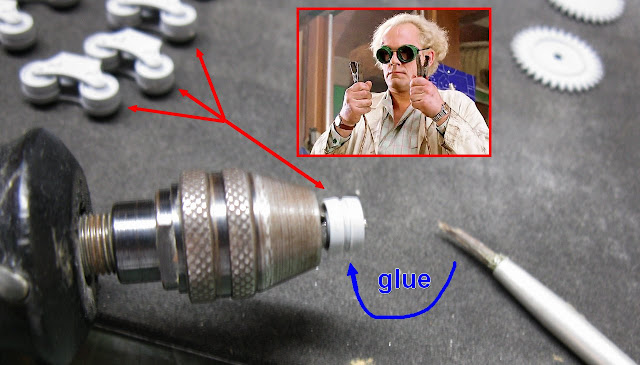




Hello, Panzerserra! This is an excellent project, I really am interested in French armored vehicles and the battles through the Low Countries and France. It seems in many ways that French AFVs were technically superior to those of the other nations.
ResponderExcluirICM make good kits, I'll have to get a FCM 36 for myself.
Hello Tank Girl!!
ExcluirWelcome back... (and come back often!!)
Yes, French tanks were superior to their contemporaries in many ways, but they had one fatal flaw; the turret that overloaded the tasks of the commander of the car: he was both commander and gunner. Not to mention the tactics employed by the French, clearly outdated in relation to the Germans, for example. But in terms of material, without a doubt, the French tanks were excellent. About the ICM kit, I recommend it without any restriction: a delight to assemble, especially this FCM 36!!! If you throw the pieces in the air, there is a high possibility that they will fit together when they fall to the ground..... Very nice to build!!! Merry X'mas and Happy new Year!!!!
So glad to see this girl get some colors! The French tank camouflage schemes and markings are so interesting. I really need to get some French tanks for my collection. For now, I've been working on a Takom 1/35 M48A5 I got for Christmas. I love Cold War armor.
ResponderExcluirHi, Tank Girl... Indeed, French camos are unique and quite eye-catching. Now, le Blanc 51 is going to be given a dirt bath, to make it look more operational. Good time choice, my friend...Cold War is an excellent theme, with innovative machines...and that are still circulating around here today... It's a pleasure to see you back here... Big hug!!!
Excluir~hugs~ to you! I do armor from WW2 to today, I really am interested in the Cold War vehicles, I was a teen when the Berlin Wall came down. I like to have comparitive subjects, too. I have a Trumpeter IT-1 missile tank and a couple of M551 Sheridan AAVs, for example.
ExcluirHi, Tank-Girl... yes... I also saw the Iron Curtain fall, too... From a distance, but following it very carefully. A pity that things seem to be happening again... Man never learns from his own mistakes... But back to the models: really, a collection of comparative models is always very illustrative. I love to follow the "evolution of time" in terms of technology when we build these combat vehicles... The eternal search for a remedy for a certain disease... Take care out there, my friend!! All the best!!!
Excluir